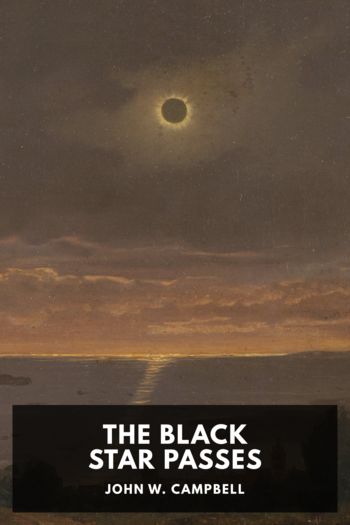The Black Star Passes by John W. Campbell (read e book .txt) 📕

- Author: John W. Campbell
Book online «The Black Star Passes by John W. Campbell (read e book .txt) 📕». Author John W. Campbell
“Where shall we go first, Dick?” asked Wade softly as he gazed out at the far-off suns of space, his voice unconsciously hushed by the grandeur of the spectacle.
“I’ve thought of that for the last four months, and now that we are definitely going to go, we’ll have to make a decision. Actually, it won’t be too hard to decide. Of course we can’t leave the solar system. And the outer planets are so far away that I think we had better wait till later trips. That leaves the choice really between Mars, Venus, and Mercury. Mercury isn’t practical since it’s so close to the sun. We know a fair bit about Mars from telescopic observation, while Venus, wrapped in perpetual cloud, is a mystery. What do you vote?”
“Well,” said Morey, “it seems to me it’s more fun to explore a completely unknown planet than one that can be observed telescopically. I vote Venus.” Each of the others agreed with Morey that Venus was the logical choice.
By this time the machine had sunk to the roof of their apartment, and the men disembarked and entered. The next day they were to start the actual work of designing the space ship.
II“When we start this work,” Arcot began next morning, “we obviously want to design the ship for the conditions we expect to meet, and for maximum convenience and safety. I believe I’ve thought about this trip longer than the rest of you, so I’ll present my ideas first.
“We don’t actually know anything about conditions on Venus, since no one has actually been there. Venus is probably a younger planet than Earth. It’s far nearer the sun than we are, and it gets twice the heat we do. In the long-gone time when the planets were cooling I believe Venus required far longer than Earth, for the inpouring heat would retard its cooling. The surface temperature is probably about 150 degrees Fahrenheit.
“There is little land, probably, for with the cloud-mass covering Venus as it does, it’s logical to visualize tremendous seas. What life has developed must be largely aquatic, and the land is probably far behind us in evolution. Of course, Venus is the planet of mystery—we don’t know; we can only guess. But we do know what things we are going to need to cross space.
“Obviously, the main driving force will be the power units. These will get their energy from the rays of the sun by absorbing them in copper discs about twelve feet in diameter—the ship will have to be more of a disc than a cylinder. I think a ship a hundred and eighty feet long, fifty feet wide, and twenty feet deep will be about the best dimensions. The power units will be strung along the top of the ship in double rows—one down each side of the hull. In the middle will be a series of fused quartz windows, opening into a large room just under the outer shell. We’ll obviously need some source of power to activate the power tubes that run the molecular motion power units. We’ll have a generator run by molecular motion power units in here, absorbing its heat from the atmosphere in this room. The air will be heated by the rays of the sun, of course, and in this way we’ll get all our power from the sun itself.
“Since this absorption of energy might result in making the ship too cool, due to the radiation of the side away from the sun, we’ll polish it, and thus reduce the unlighted side’s radiation.
“The power units will not be able to steer us in space, due to their position, and those on the sides, which will steer us in the atmosphere by the usual method, will be unable to get the sun’s power; they’ll be shaded. For steering in space, we’ll use atomic hydrogen rockets, storing the atomic gas by the Wade method in tanks in the hold. We’ll also have a battery down there for starting the generator and for emergencies.
“For protection against meteors, we’ll use radar. If anything comes within a dozen miles of us, the radar unit covering that sector will at once set automatic machinery in operation, and the rockets will shoot the ship out of the path of the meteor.”
All that day Arcot and the others discussed the various pieces of apparatus they would need, and toward evening Fuller began to draw rough sketches of the different mechanisms that had been agreed upon.
The next day, by late afternoon, they had planned the rough details of the ship and had begun the greater task of calculating the stresses and the power factors.
“We won’t need any tremendous strength for the ship while it is in space,” Arcot commented, “for then there will be little strain on it. It will be weightless from the start, and the gentle acceleration will not strain it in the least, but we must have strength, so that it can maneuver in the atmosphere.
“We’ll leave Earth by centrifugal force, for I can make much better speed in the atmosphere where there is plenty of power to draw on; outside I must depend solely on sunlight. We’ll circle the Earth, forming an orbit just within the atmosphere, at five miles a second. We’ll gradually increase the speed to about ten miles a second, at which point the ship would normally fly off into space under its own centrifugal force. With the power units we’ll prevent its release until the proper moment. When we release it, it will be entirely free of Earth, and no more work will be needed to overcome Earth’s pull.”
The planning continued with exasperating slowness. The details of the work were complex, for all the machines were totally new. Several weeks passed before even the power units could





Comments (0)